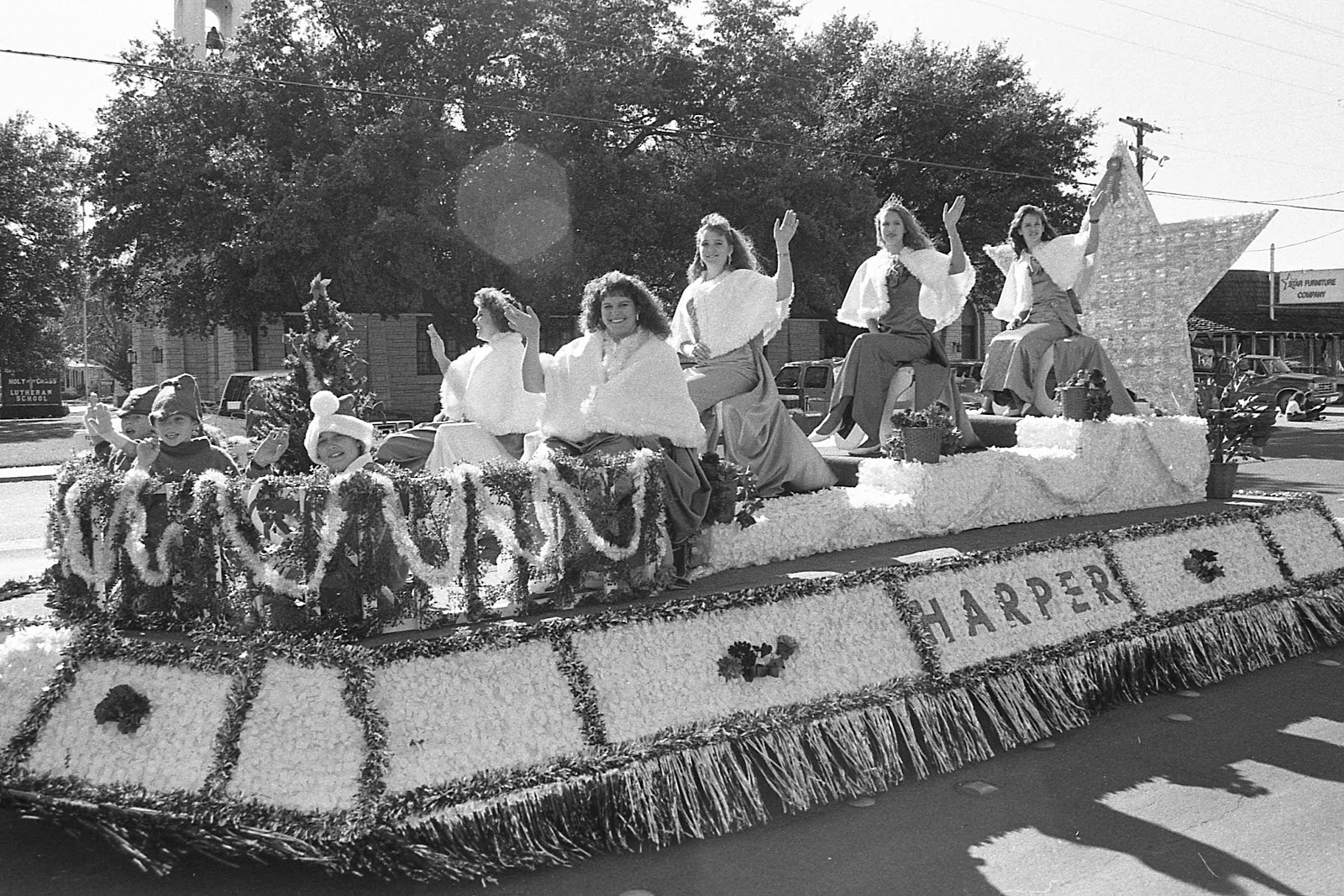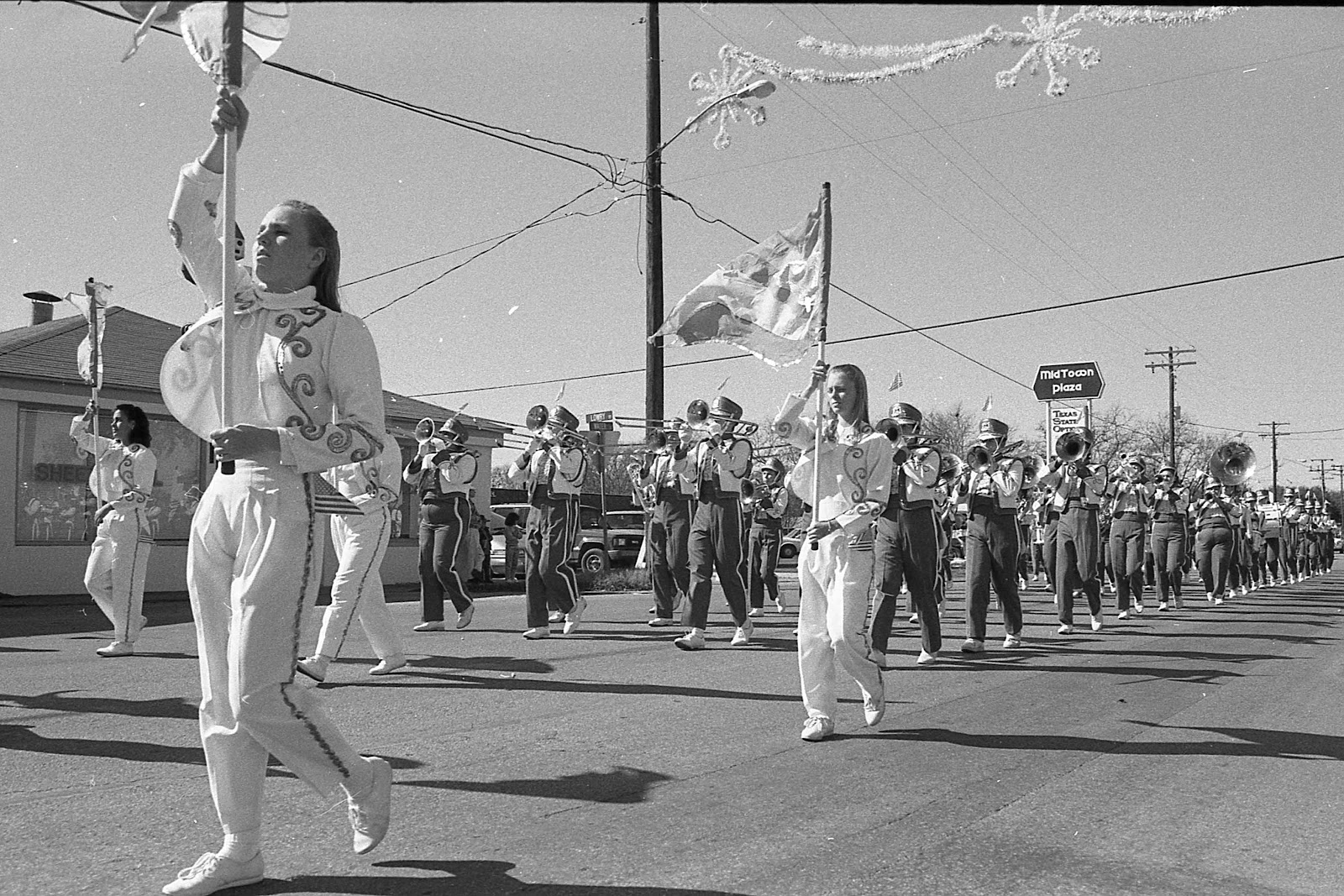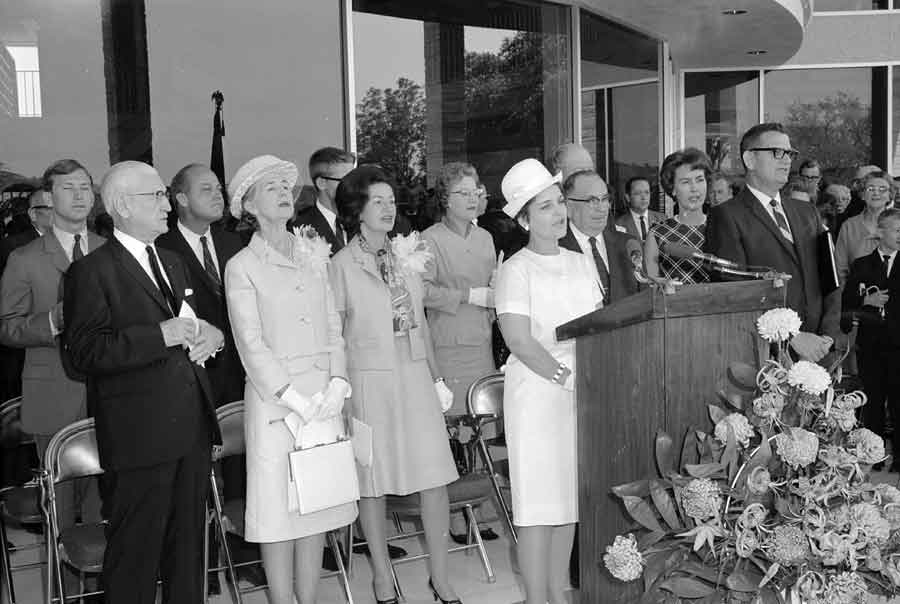 |
Lady Bird Johnson at the dedication of Kerrville's
Butt-Holdsworth Memorial Library, August 26, 1967.
Click on any image to enlarge. |
A kind reader found an interesting government document – and sent it along to me a few weeks ago.
In its upper left corner, it reads “The White House, Washington.” Towards the right, it reads “Mrs. Lyndon B. Johnson, Daily Diary.” It is dated 26 August 1967.
She had a busy day that day – starting at the LBJ Ranch, near Stonewall, Texas, she left for Kerrville at 10:15. Arriving at 10:57, the diary reads “Arrived at the Butt-Holdsworth Memorial Library in Kerrville for dedication ceremonies; planted a tree; toured the Library and attended reception. Breathtaking view overlooking the Guadaloupe [sic] River.”
She left Kerrville at 12:45, and headed back to the ranch, arriving at 1:27.
I was intrigued by the rest of her day. She left the ranch by small plane at 10:15 that evening, arrived in Dallas and flew on American Airlines Flight #598 to “Friendship” Airport. She was driven from the airport to Mount Vernon dock, where she boarded the presidential yacht, the USS Sequoia, at 3:20 am the following day – August 27, 1967.
Now why did she need to travel through the night from Texas to get aboard a yacht at Mount Vernon? More on that later.
On August 26, 1967, our community celebrated the grand opening of the Butt-Holdsworth Memorial Library at a dedication ceremony attended by 2,500 people, including Lady Bird Johnson and the donors of the library building, Howard and Mary Butt. It was truly one of the red-letter days in our community's history, marking the culmination of a decades-long dream while also expressing great hope for the future of Kerrville and Kerr County.
The new library building, at 505 Water Street, was built on a site overlooking the Guadalupe River, and was a gift of Howard and Mary Butt, both Tivy High School graduates with family ties in Kerr County, and designated as a memorial to their families.
It was designed by the architectural firm of Christian, Bright & Pennington of Corpus Christi, and construction was under the supervision of J. H. Daniel of San Antonio, with Lawrence Goodrich the foreman in charge of construction. The landscape architect was Durward Thompson.
Overall, the building had floor space of over 21,000 square feet on three floors, and the building itself closely resembles in appearance and design the library built for the University of Corpus Christi, Texas, in 1963. That building was also a gift of Howard and Mary Butt, and is still in use on what is now the Texas A&M University at Corpus Christi as an administration building.
Our library building features a mural of Kerr County history by Merrill Doyle, and mosaic tile artwork by Salina Saur. Tiles by Mary Green decorated the amphitheater, featuring characters from books for children. The decoupage panels decorated the children's reading area were made by Christine Gerber. Dotted around the property were quotes from literature and phrases from poetry, selected by Mary Butt.
From beginning to completion, the planning and construction of the building took about 18 months. At the dedication ceremony, Howard Butt thanked his wife Mary for her dedication to the project.
"If this building's beauty, character, and functional qualities are above the ordinary," he said, "I want to pay tribute to my wife who has dedicated at least a year and a half of her life to planning it."
Lady Bird Johnson also praised Mary Holdsworth Butt's work on the library.
"Mrs. Butt," the First Lady said, "who has become conversant with every brick and stone and light plug since its inception tells me that it has room to grow immediately from its wonderful collection of 20,000 to 75,000 volumes. With great relish she told me of the day the school children carried loads of books from the old library into this one, and of last week how so many of the community leaders were handling the phone calls and last-minute chores to prepare for this day."
August 26, 1967 was a hot day in Kerrville. Even though fifty years have passed, people remember how hot it was that day. Ruth Hinkle remembers "it was extremely hot, several people fainted." Steve Meeker remembers the same "it was very hot and several people did faint."
Mrs. W. A. Salter wrote about the day in her column in the August 30, 1967 issue of the Kerrville Mountain Sun: "The day was one of beauty...the mist on the river, the haze on the hills...the washed look of the world and the sunshine bathing the scene...and the magnificent setting."
The hot weather did not keep the crowds away. 2,500 people attended the ceremony, which was about a quarter of the population of Kerrville. Those who were not included in the guest list admitted inside the building filled up the area below the library, between the library and the river bluff. It was quite a crowd, but from the photos, you can tell it was a special occasion. "My mom made us dress up for the occasion," Sue Alice Jackson Shay remembers.
Photographs of the event, especially candid photos taken by those who attended, clearly show how excited and happy everyone was. The new library was a big deal to the community, and not just as a physical building. The ideas behind the library were just as important.
"Perhaps no place in any community is as totally democratic as the town library," Lady Bird Johnson said in her address. "The only entrance requirement is interest, whether you are a Ph.D. or haven't even started school. It is here that you can communicate with the liveliest minds of the ages...Books are the scissors by which man can cut his bonds of his own ignorance. I salute all the planners who have seen that this library is not only a landmark of learning, but a landmark of beauty. This is, indeed, a proud day for all of us."
Charles Butt, the youngest son of Howard and Mary Butt, has provided support for the library for decades, including for the last series of renovations completed several years ago. He also spoke at the dedication fifty years ago, expressing in an invocation his hope that the library help spread knowledge and "put an end to mistrust, prejudice and ignorance."
At the end of the ceremony, Howard and Mary Butt gave the keys to the building to Kerrville mayor Gordon Monroe and the county judge of Kerr County, Julius Neunhoffer.
"It is our privilege to deliver the possession of this beautiful building," Howard Butt said, "of making this gift of what we hope will be a great institution to serve the people of the Hill Country and the children for years and years to come."
I was a child when the library opened, and I know this hope was fulfilled. Not just for me, but for many children, including my own, decades later.
Now – what about Mrs. Johnson, who traveled from the LBJ Ranch to Mount Vernon, to board the Sequoia?
At 4:32 am, the day after the library dedication, her official Daily Diary has this entry: “4:32 am, Arrived on board the Sequoia – had to walk through the ‘Men’s dormitory’ – went immediately to bed.
If President Johnson woke up at her arrival, I think I know what she told him.
“Happy Birthday, Lyndon.”
So – there was a reason she needed get back to Washington by Sunday, August 27, 1967.
I’m thankful to the kind reader for sending along this small bit of ephemera – and for the rest of the story it told. If you’d care to read more about Mrs. Johnson’s daily schedule, the diary entry can be found at https://discoverlbj.org/item/ctjd-ctjdd-19670826
Until next week, all the best.
Joe Herring Jr. is a Kerrville native who thinks he was at the opening ceremony for the library – as a 6-year-old just about to start first grade. This column originally appeared in the Kerr County Lead March 6, 2025.
Thanks for reading. This newsletter is free, but not cheap to send. To show your support, forward it to someone who’d like it, or buy one of my books. Thanks so much. (And thanks to all of you who bought books this week!)
Never miss a story from Joe. Join today for FREE.









































